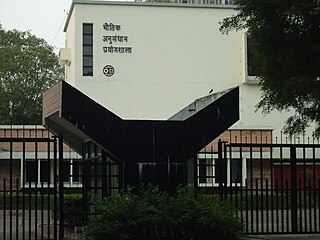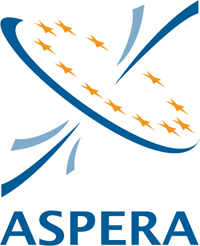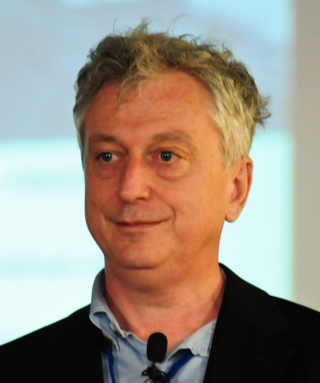Related Research Articles

Riccardo Giacconi was an Italian-American Nobel Prize-winning astrophysicist who laid down the foundations of X-ray astronomy. He was a professor at the Johns Hopkins University.

Astrophysics is a science that employs the methods and principles of physics and chemistry in the study of astronomical objects and phenomena. As one of the founders of the discipline, James Keeler, said, Astrophysics "seeks to ascertain the nature of the heavenly bodies, rather than their positions or motions in space–what they are, rather than where they are." Among the subjects studied are the Sun, other stars, galaxies, extrasolar planets, the interstellar medium and the cosmic microwave background. Emissions from these objects are examined across all parts of the electromagnetic spectrum, and the properties examined include luminosity, density, temperature, and chemical composition. Because astrophysics is a very broad subject, astrophysicists apply concepts and methods from many disciplines of physics, including classical mechanics, electromagnetism, statistical mechanics, thermodynamics, quantum mechanics, relativity, nuclear and particle physics, and atomic and molecular physics.

The International Union of Pure and Applied Physics is an international non-governmental organization whose mission is to assist in the worldwide development of physics, to foster international cooperation in physics, and to help in the application of physics toward solving problems of concern to humanity. It was established in 1922 and the first General Assembly was held in 1923 in Paris. The Union is domiciled in Geneva, Switzerland.

MAGIC is a system of two Imaging Atmospheric Cherenkov telescopes situated at the Roque de los Muchachos Observatory on La Palma, one of the Canary Islands, at about 2200 m above sea level. MAGIC detects particle showers released by gamma rays, using the Cherenkov radiation, i.e., faint light radiated by the charged particles in the showers. With a diameter of 17 meters for the reflecting surface, it was the largest in the world before the construction of H.E.S.S. II.
Reuven Ramaty (1937—2001) was a Hungarian astrophysicist who worked for 30 years at NASA's NASA Goddard Space Flight Centre. He was a leader in the fields of solar physics, gamma-ray line spectrometry, nuclear astrophysics, and low-energy cosmic rays. Ramaty was a founding member of NASA's High Energy Solar Spectroscopic Imager which has now been renamed the Reuven Ramaty High Energy Solar Spectroscopic Imager in his honour. This was the first space mission to be named after a NASA scientist and was operational from 2002 until 2018. The Online Archive of California holds over 400 entries for documents, papers and photographs published by and of Ramaty and his work. Ramaty made many contributions in the field of astrophysics and solar physics. He was given the Goddard Lindsay Award in 1980 and had a tribute dedicated to his work at the University of Maryland in 2000.

The Physical Research Laboratory is a National Research Institute for space and allied sciences, supported mainly by Department of Space, Government of India. This research laboratory has ongoing research programmes in astronomy and astrophysics, atmospheric sciences and aeronomy, planetary and geosciences, Earth sciences, Solar System studies and theoretical physics. It also manages the Udaipur Solar Observatory and Mount Abu InfraRed Observatory. The PRL is located in Ahmedabad.
Astroparticle physics, also called particle astrophysics, is a branch of particle physics that studies elementary particles of astronomical origin and their relation to astrophysics and cosmology. It is a relatively new field of research emerging at the intersection of particle physics, astronomy, astrophysics, detector physics, relativity, solid state physics, and cosmology. Partly motivated by the discovery of neutrino oscillation, the field has undergone rapid development, both theoretically and experimentally, since the early 2000s.

ASPERA is a network of national government agencies responsible for coordinating and funding national research efforts in astroparticle physics.
Andrew Christopher Fabian is a British astronomer and astrophysicist. He was Director of the Institute of Astronomy, University of Cambridge from 2013 to 2018. He was a Royal Society Research Professor at the Institute of Astronomy, Cambridge from 1982 to 2013, and Vice-Master of Darwin College, Cambridge from 1997 to 2012. He served as president of the Royal Astronomical Society from May 2008 through to 2010.
STATPHYS or IUPAP International Conference on Statistical Physics is a series of conferences organized by the International Union of Pure and Applied Physics. The conferences take place every three years in a different continent to give the maximum international relevance and visibility to the event. It is the world event for the broad field of statistical physics and all its interdisciplinary developments. The first meeting was in Florence (Italy) from 17 to 20 May 1949. After a pioneering period the periodicity of three years was established and the conference has acquired more and more importance. The participation has reached peaks up to 1500 participants in the recent years. Also on the occasion of this conference the prestigious Boltzmann medal is awarded. In addition several satellite meetings are usually held along with the main event, adding to the scientific value of the meeting.
Aleksandr Evgenievich Chudakov was a Soviet Russian physicist in the field of cosmic-ray physics, known for Chudakov Effect, the effect of decreasing ionization losses for narrow electron-positron pairs and for experimentally confirming existence of the transition radiation. He was also the chairman of the IUPAP Cosmic Ray Commission.

Geraint Francis Lewis, FLSW is a Welsh astrophysicist, who is best known for his work on dark energy, gravitational lensing and galactic cannibalism. Lewis is a Professor of Astrophysics at the Sydney Institute for Astronomy, part of the University of Sydney's School of Physics. He is head of the Gravitational Astrophysics Group. He was previously the Associate Head for Research at the School of Physics, and held an Australian Research Council Future Fellowship between 2011 and 2015. Lewis won the 2016 Walter Boas Medal in recognition of excellence in research in Physics. In 2021, he was awarded the David Allen Prize of the Astronomical Society of Australia for exceptional achievement in astronomy communication.

Alan Andrew Watson, FRS, is a physicist and an emeritus professor at the University of Leeds, England.
The International Conference on Neutrino Physics and Astrophysics is a significant international conference series in the field of neutrino physics, during which talks detailing notable progress in theoretical and experimental work are given. In addition, the conference reviews the status of proposed research in neutrino physics and astrophysics. Held every two years, the conference programs consist of plenary sessions with invited speakers, poster sessions and short evening talks. The shorthand designator for a particular conference is "Neutrino" followed by its year, e.g. Neutrino 2011.
Felix A. Aharonian is a physicist and astrophysicist. He is a recognized authority on the origin of cosmic rays, and has written books and research papers on astroparticle physics, and cosmology.
Ramanath Cowsik is an Indian astrophysicist and the James S. McDonnell Professor of Space Sciences at Washington University in St. Louis. He is considered by many as the father of astroparticle physics. A recipient of the Shanti Swarup Bhatnagar Prize, Cowsik was honored by the Government of India, in 2002, with the fourth highest Indian civilian award of Padma Shri

Angela Villela Olinto is an astroparticle physicist and the Albert A. Michelson Distinguished Service Professor at the University of Chicago as well as the dean of the Physical Sciences Division. Her current work is focused on understanding the origin of high-energy cosmic rays, gamma rays, and neutrinos.
The Bartol Research Institute is a scientific research institution at the Department of Physics and Astronomy of the University of Delaware. Its members belong to the faculty of the University of Delaware and perform research in areas such as astroparticle physics, astrophysics, cosmology, particle physics, and space science.

Alessandro De Angelis is an Italian and Argentine physicist and astrophysicist. A Professor of Experimental Physics at the University of Padova and Professor Catedratico of Astroparticle Physics at IST Lisboa, he is mostly known for his role in the proposal, construction and data analysis of new telescopes for gamma-ray astrophysics. He is a member of Istituto nazionale di fisica nucleare (INFN), Istituto nazionale di astrofisica (INAF), Italian Physical Society (SIF), International Astronomical Union (IAU), Gruppo2003.
References
- ↑ O’Ceallaigh Medal Dublin Institute for Advanced Studies